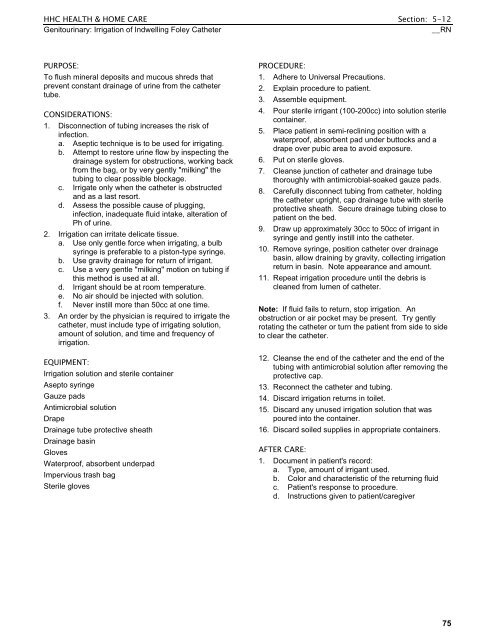HHC Health & Home Care Clinical Policy And
HHC Health & Home Care Clinical Policy And
HHC Health & Home Care Clinical Policy And
Create successful ePaper yourself
Turn your PDF publications into a flip-book with our unique Google optimized e-Paper software.
<strong>HHC</strong> HEALTH & HOME CARE Section: 5-12<br />
Genitourinary: Irrigation of Indwelling Foley Catheter __RN<br />
PURPOSE: PROCEDURE:<br />
To flush mineral deposits and mucous shreds that<br />
prevent constant drainage of urine from the catheter<br />
tube.<br />
CONSIDERATIONS:<br />
1. Disconnection of tubing increases the risk of<br />
infection.<br />
a. Aseptic technique is to be used for irrigating.<br />
b. Attempt to restore urine flow by inspecting the<br />
drainage system for obstructions, working back<br />
from the bag, or by very gently "milking" the<br />
tubing to clear possible blockage.<br />
c. Irrigate only when the catheter is obstructed<br />
and as a last resort.<br />
d. Assess the possible cause of plugging,<br />
infection, inadequate fluid intake, alteration of<br />
Ph of urine.<br />
2. Irrigation can irritate delicate tissue.<br />
a. Use only gentle force when irrigating, a bulb<br />
syringe is preferable to a piston-type syringe.<br />
b. Use gravity drainage for return of irrigant.<br />
c. Use a very gentle "milking" motion on tubing if<br />
1. Adhere to Universal Precautions.<br />
2. Explain procedure to patient.<br />
3. Assemble equipment.<br />
4. Pour sterile irrigant (100-200cc) into solution sterile<br />
container.<br />
5. Place patient in semi-reclining position with a<br />
waterproof, absorbent pad under buttocks and a<br />
drape over pubic area to avoid exposure.<br />
6. Put on sterile gloves.<br />
7. Cleanse junction of catheter and drainage tube<br />
thoroughly with antimicrobial-soaked gauze pads.<br />
8. <strong>Care</strong>fully disconnect tubing from catheter, holding<br />
the catheter upright, cap drainage tube with sterile<br />
protective sheath. Secure drainage tubing close to<br />
patient on the bed.<br />
9. Draw up approximately 30cc to 50cc of irrigant in<br />
syringe and gently instill into the catheter.<br />
10. Remove syringe, position catheter over drainage<br />
basin, allow draining by gravity, collecting irrigation<br />
return in basin. Note appearance and amount.<br />
this method is used at all. 11. Repeat irrigation procedure until the debris is<br />
d. Irrigant should be at room temperature.<br />
cleaned from lumen of catheter.<br />
e. No air should be injected with solution.<br />
3.<br />
f. Never instill more than 50cc at one time.<br />
An order by the physician is required to irrigate the<br />
catheter, must include type of irrigating solution,<br />
amount of solution, and time and frequency of<br />
irrigation.<br />
Note: If fluid fails to return, stop irrigation. An<br />
obstruction or air pocket may be present. Try gently<br />
rotating the catheter or turn the patient from side to side<br />
to clear the catheter.<br />
EQUIPMENT:<br />
Irrigation solution and sterile container<br />
12. Cleanse the end of the catheter and the end of the<br />
tubing with antimicrobial solution after removing the<br />
protective cap.<br />
Asepto syringe 13. Reconnect the catheter and tubing.<br />
Gauze pads 14. Discard irrigation returns in toilet.<br />
Antimicrobial solution 15. Discard any unused irrigation solution that was<br />
Drape<br />
poured into the container.<br />
Drainage tube protective sheath<br />
16. Discard soiled supplies in appropriate containers.<br />
Drainage basin<br />
Gloves<br />
AFTER CARE:<br />
Waterproof, absorbent underpad<br />
Impervious trash bag<br />
1. Document in patient's record:<br />
a. Type, amount of irrigant used.<br />
b. Color and characteristic of the returning fluid<br />
Sterile gloves c. Patient's response to procedure.<br />
d. Instructions given to patient/caregiver<br />
75







